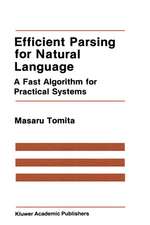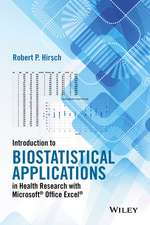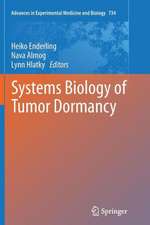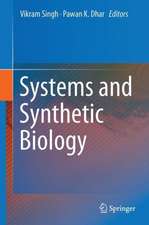E‑Cell System: Basic Concepts and Applications: Molecular Biology Intelligence Unit, cartea 118
Editat de Satya Nanda Vel Arjunan, Pawan K. Dhar, Masaru Tomitaen Limba Engleză Paperback – 23 aug 2016
| Toate formatele și edițiile | Preț | Express |
|---|---|---|
| Paperback (1) | 770.35 lei 6-8 săpt. | |
| Springer – 23 aug 2016 | 770.35 lei 6-8 săpt. | |
| Hardback (1) | 1083.10 lei 3-5 săpt. | |
| Springer – 25 ian 2013 | 1083.10 lei 3-5 săpt. |
Din seria Molecular Biology Intelligence Unit
- 5%
 Preț: 663.60 lei
Preț: 663.60 lei - 18%
 Preț: 1220.03 lei
Preț: 1220.03 lei - 5%
 Preț: 1083.10 lei
Preț: 1083.10 lei - 24%
 Preț: 775.98 lei
Preț: 775.98 lei - 18%
 Preț: 1217.54 lei
Preț: 1217.54 lei - 15%
 Preț: 637.78 lei
Preț: 637.78 lei - 5%
 Preț: 1090.37 lei
Preț: 1090.37 lei - 15%
 Preț: 633.41 lei
Preț: 633.41 lei - 18%
 Preț: 938.03 lei
Preț: 938.03 lei - 5%
 Preț: 710.81 lei
Preț: 710.81 lei - 20%
 Preț: 552.98 lei
Preț: 552.98 lei - 5%
 Preț: 1088.55 lei
Preț: 1088.55 lei - 5%
 Preț: 1089.61 lei
Preț: 1089.61 lei - 18%
 Preț: 935.98 lei
Preț: 935.98 lei - 18%
 Preț: 1213.46 lei
Preț: 1213.46 lei - 5%
 Preț: 1398.56 lei
Preț: 1398.56 lei - 18%
 Preț: 940.07 lei
Preț: 940.07 lei - 5%
 Preț: 1086.53 lei
Preț: 1086.53 lei - 18%
 Preț: 938.82 lei
Preț: 938.82 lei - 24%
 Preț: 1053.39 lei
Preț: 1053.39 lei - 24%
 Preț: 786.18 lei
Preț: 786.18 lei - 24%
 Preț: 789.89 lei
Preț: 789.89 lei - 18%
 Preț: 938.64 lei
Preț: 938.64 lei - 5%
 Preț: 1087.81 lei
Preț: 1087.81 lei - 5%
 Preț: 1418.73 lei
Preț: 1418.73 lei - 24%
 Preț: 817.70 lei
Preț: 817.70 lei - 5%
 Preț: 1096.69 lei
Preț: 1096.69 lei - 18%
 Preț: 940.86 lei
Preț: 940.86 lei - 15%
 Preț: 636.17 lei
Preț: 636.17 lei - 18%
 Preț: 944.27 lei
Preț: 944.27 lei - 5%
 Preț: 1087.65 lei
Preț: 1087.65 lei - 18%
 Preț: 943.34 lei
Preț: 943.34 lei - 18%
 Preț: 939.58 lei
Preț: 939.58 lei - 18%
 Preț: 945.86 lei
Preț: 945.86 lei - 5%
 Preț: 709.36 lei
Preț: 709.36 lei - 18%
 Preț: 939.44 lei
Preț: 939.44 lei - 18%
 Preț: 940.86 lei
Preț: 940.86 lei - 18%
 Preț: 948.97 lei
Preț: 948.97 lei - 5%
 Preț: 1293.02 lei
Preț: 1293.02 lei - 5%
 Preț: 1090.54 lei
Preț: 1090.54 lei - 18%
 Preț: 937.23 lei
Preț: 937.23 lei - 18%
 Preț: 943.51 lei
Preț: 943.51 lei - 24%
 Preț: 782.70 lei
Preț: 782.70 lei - 18%
 Preț: 946.62 lei
Preț: 946.62 lei - 15%
 Preț: 635.34 lei
Preț: 635.34 lei - 5%
 Preț: 1598.77 lei
Preț: 1598.77 lei - 18%
 Preț: 940.38 lei
Preț: 940.38 lei - 18%
 Preț: 1222.23 lei
Preț: 1222.23 lei - 15%
 Preț: 644.30 lei
Preț: 644.30 lei - 18%
 Preț: 1222.06 lei
Preț: 1222.06 lei
Preț: 770.35 lei
Preț vechi: 810.89 lei
-5% Nou
Puncte Express: 1156
Preț estimativ în valută:
147.53€ • 150.55$ • 124.12£
147.53€ • 150.55$ • 124.12£
Carte tipărită la comandă
Livrare economică 26 februarie-12 martie
Preluare comenzi: 021 569.72.76
Specificații
ISBN-13: 9781493947614
ISBN-10: 1493947613
Pagini: 179
Ilustrații: XIV, 179 p.
Dimensiuni: 178 x 254 mm
Greutate: 0.35 kg
Ediția:Softcover reprint of the original 1st ed. 2013
Editura: Springer
Colecția Springer
Seria Molecular Biology Intelligence Unit
Locul publicării:New York, NY, United States
ISBN-10: 1493947613
Pagini: 179
Ilustrații: XIV, 179 p.
Dimensiuni: 178 x 254 mm
Greutate: 0.35 kg
Ediția:Softcover reprint of the original 1st ed. 2013
Editura: Springer
Colecția Springer
Seria Molecular Biology Intelligence Unit
Locul publicării:New York, NY, United States
Cuprins
Introduction to Whole Cell Modeling.- Foundations of E‑Cell Simulation Environment Architecture.- Distributed Cell Biology Simulations with the E‑Cell System.- A Guide to Modeling Reaction‑Diffusion of Molecules with the E‑Cell System.- A Model Library of Bacterial Chemotaxis on E‑Cell System.- Electrophysiological Simulation of Developmental Changes in Action Potentials of Cardiomyocytes.- Simulation of Human Erythrocyte Metabolism.- Dynamic Kinetic Modeling of Mitochondrial Energy Metabolism.- A Computational Model of the Hepatic Lobule.- Decoding the Signaling Mechanism of Toll‑Like Receptor 4 Pathways in Wild Type and Knockouts.- Modeling of Hsp70‑Mediated Protein Refolding.
Notă biografică
Satya Arjunan is a Postdoctoral Researcher at the RIKEN Quantitative Biology Center, Japan. He received his PhD in Systems Biology from Keio University (2009), BEng in Electronics Engineering (2000) and MSc (2003) in Computer Science from Universiti Teknologi Malaysia. He is also the recipient of the Texas Instruments Malaysia Scholarship (1997) and the Monbukagakusho Scholarship (2003). As part of his PhD work, he developed a multicompartmental spatiotemporal stochastic simulation method, called Spatiocyte, with applications in molecular systems biology.
Pawan K. Dhar is the Director of the Centre of Systems and Synthetic Biology, University of Kerala. Prior to this he held senior scientific positions at RIKEN Genomics Sciences Centre, Japan, Bioinformatics Institute, Singapore and the E-Cell group, Keio University in Japan and Manipal University. One of his key recent contributions has been to make functional proteins from non‑coding genome. Dr. Dhar is the Founding Editor-in-Chief of the Springer's System and Synthetic Biology Journal. Dr. Dhar heads active research programs on synthetic proteins, virtual cell and BioCAD platform.
Masaru Tomita is a Professor and the Director General of the Institute for Advanced Biosciences, Keio University. He received PhD in Computer Science from Carnegie Mellon University (1985), PhD in Electrical Engineering from Kyoto University (1994) and PhD in Molecular Biology from Keio University (1998). He is a recipient of Presidential Young Investigators Award from National Science Foundation of USA (1988) and various other awards. His current research field includes Systems Biology, Metabolomics, and Computational Biology.
Pawan K. Dhar is the Director of the Centre of Systems and Synthetic Biology, University of Kerala. Prior to this he held senior scientific positions at RIKEN Genomics Sciences Centre, Japan, Bioinformatics Institute, Singapore and the E-Cell group, Keio University in Japan and Manipal University. One of his key recent contributions has been to make functional proteins from non‑coding genome. Dr. Dhar is the Founding Editor-in-Chief of the Springer's System and Synthetic Biology Journal. Dr. Dhar heads active research programs on synthetic proteins, virtual cell and BioCAD platform.
Masaru Tomita is a Professor and the Director General of the Institute for Advanced Biosciences, Keio University. He received PhD in Computer Science from Carnegie Mellon University (1985), PhD in Electrical Engineering from Kyoto University (1994) and PhD in Molecular Biology from Keio University (1998). He is a recipient of Presidential Young Investigators Award from National Science Foundation of USA (1988) and various other awards. His current research field includes Systems Biology, Metabolomics, and Computational Biology.
Caracteristici
Provides an overview of whole cell modeling and its fundamental concepts Describes the Spatiocyte lattice-based simulation method which is developed as a set of E-Cell System plug in modules Provides examples of actual modeling applications that use the E-Cell System

















